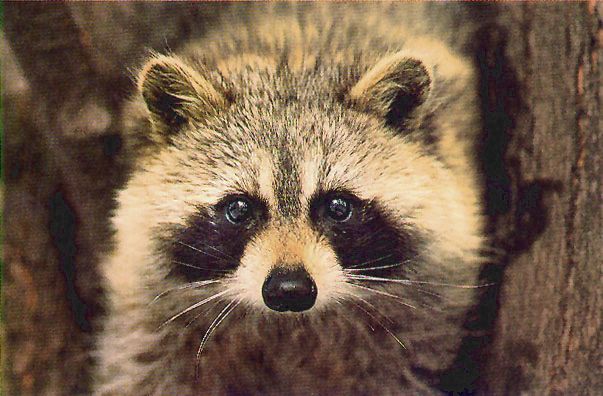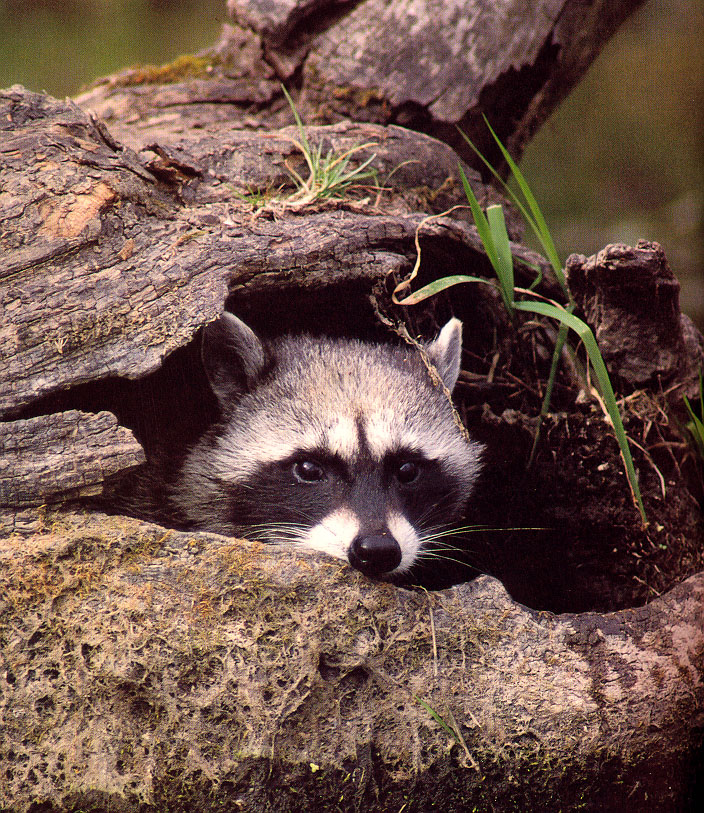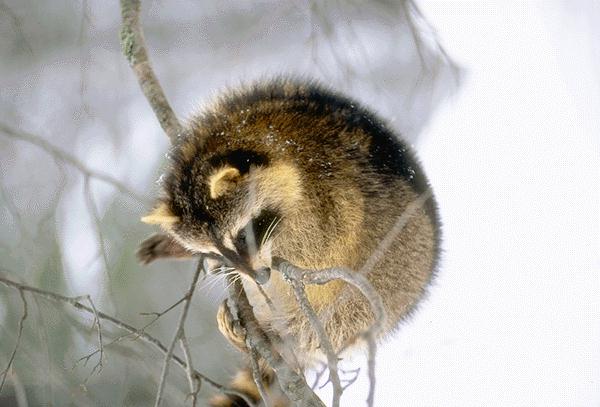Raccoon - (Procyon lotor)

![]()


![]()
Managing Raccoon Problems
Raccoons can
sometimes be a nuisance to plants in your backyard or get
into your attic, but you should never, ever forcibly remove them or do anything
that could bring them harm. Call a raccoon
removal service that will make sure they get back to their natural habitat
in the most humane manner possible. Or, if you don’t mind having the little
guys in your yard, you could always try leaving them a snack!
Raccoons (Procyon Lotor) are medium sized animals, 12 - 35 + lbs. and 20 - 40 inches long, including a bushy tail with 4 to 7 black rings. The fur has a salt and pepper appearance with the black mask marking on a whitish face characteristic of the species. The tracks of the raccoon are very distinctive. The hind foot is long, narrow, and rests flat on the ground like those of a bear. The front paw is hand-like, with toes that are long and well separated. This permits the use of the front paws with almost the facility of a monkey's hands.
Biology
Raccoons breed mainly in February and March, but matings may occur from December through June. The gestation period is about 63 days. Most litters are born in April or May, but some late-breeding females may not give birth until June, July, or August. Raccoons produce one litter per year. The average litter size is 3 to 5 young. The offspring are weaned between 2 and 4 months of age and usually stay with the female until the following spring. Yearling females do not always breed but adult females normally breed every year, especially if food is plentiful.
The diet of the raccoon is extremely diverse. They will eat fruit, berries, grain, eggs, poultry, vegetables, nuts, mollusks, fish, insects, rodents, carrion, pet food and garbage. Individual animals may learn to use specialized foods such as poultry, fruit crops, small livestock, or garbage by watching other raccoons. Contrary to popular myth, raccoons do not always wash their food before eating, although they frequently play with their food in water.
Raccoons are nocturnal or night-time active animals. Urban raccoon populations are frequently underestimated because people seldom see them traveling during the daytime. They are also territorial, particularly the males. Adult males may occupy areas of 3 to 20 square miles; females have a much smaller territory of 1 to 6 square miles. Raccoons den up in hollow trees, drain pipes, homes and buildings, under decks and storage buildings, brush piles and abandoned burrows.
Damage
Raccoons can cause substantial damage. In urban areas, raccoons damage building (particularly attics and roofs), gardens, fruit trees, lawns, garbage cans and trash containers. They are also attracted to pet food left outdoors and will attack pets. Occasionally, one or more raccoons will establish a communal toilet area resulting in time of the deposition of a large number of scats. In rural areas, raccoons may feed on farm crops or raid poultry houses. A raccoon typically attacks birds by biting the head or upper neck area. The heads of adult birds are usually bitten off and left some distance from the body. The crop and breast may be torn and chewed and the entrails eaten. Raccoons have been known to mutilate poultry in cages by pulling heads or legs off. Several kills may be made during a single night raid with part of one or more carcasses fed upon. Dead fowl may be at the kill site or dragged several yards away. Raccoons are also serious predators of wild bird populations. Reports indicate that raccoons have been responsible for eliminating local populations of some nesting waterfowl.
Disease
Since free roaming wildlife does not receive veterinary care, all wildlife species can carry diseases and parasites. Raccoons are known carriers of rabies, canine distemper, encephalitis, histoplasmosis, trypanosomiasis, coccidiosis, toxoplasmosis, tularemia, tuberculosis, listeriosis, leptospirosis, roundworms, and mange. They are also infested with fleas, ticks, lice and mites which are known transmitters of disease. Children and pets are particularly at risk.
Problem Prevention
Raccoons are attracted to urban areas by the easy accessibility of food, water, and shelter. Reducing or eliminating the availability of all of these factors will encourage raccoons to leave. Tight fitting lids should be kept on garbage cans; pets should be fed during daylight hours and any leftovers removed immediately; water bowl should be emptied or taken in a night; gardens should be frequently harvested and windfall fruit picked up. Food should never be intentionally left out for wild mammals.
Raccoons can be excluded from building by covering foundation vents with slotted metal vent covers and by using 1/4 inch grid screening to cover attic vents and chimneys. They have been known to enter homes through pet doors; be sure these are locked at night. Raccoons sometimes take up residence under a low deck. They may be excluded by using 1/4 inch grid screening or solid metal flashing. Trench around the perimeter of the deck a minimum of 12 inches deep, insert the screening in trench and backfill. Attach the top of the screening to the facade of the deck with nails or fence post staples. Before completing the final seal on the last entry point, it is wise to make sure no animals are trapped inside. On the night before completing repairs, sprinkle flour in the entrance hole and check for tracks the following morning. If no tracks are evident for 3 consecutive nights, no animals are likely to be present. You may wish to make a temporary one-way exit using 1/4 inch grid screening. Form the screening into a cone or funnel shape that will permit animals to leave but not re-enter. The large end should be sized to encircle the entry hole and be attached over the hole to the facade of the deck or building with nails or fence post staples. The small end should face away from the house and be 4 - 6 inches in diameter.
Raccoons may be kept away from roof areas by trimming tree branches 10 feet from roof and by keeping climbing plants trimmed away from roof and eave areas.
Exclusion of raccoons from coops and poultry yards is usually the most practical and effective method to prevent losses. At night, poultry should be kept in raccoon-proof sheds or houses. Ideally, poultry should be confined day and night in a sturdy house combined with a predator-proof outdoor run area. This also provides protection from many other types of predators. Often with a few simple tools and a little material, even somewhat dilapidated coops can be rejuvenated into raccoon-proof condition. Keep in mind that raccoons are climbers. Moreover, they are strong animals capable of seizing and pushing or pulling objects with considerable force. Usually, raccoons are not inclined to break through walls or fences that are intact and in reasonably good condition. Entry is usually made through open, weak, or loose places. Following is a list of measures you can use to protect poultry from raccoons.
- 1. Cover tops of outdoor runs with wire mesh and/or suitable paneling material and fasten securely. If this is not practical, shut poultry indoors at night.
- 2. Patch or repair all holes or weak places in existing wire or wood (house or run.)
- 3. Check all edges of overlapping or stapled chicken wire for tightness and tie or staple securely.
- 4. Check ground edges of coop for tightness. Raccoons may dig under fencing or enlarge existing spaces.
- 5. Coop doors should be close fitting and sturdy. Beware of plywood doors which may have substantial warp at corners.
- 6. Simple door fasteners, such as plain hooks, should be replaced with more sophisticated devices such as safety hooks or locking hasps. Raccoons can manipulate and open elementary door latches.
- 7. To prevent raccoons from reaching in and grabbing poultry, night roosting or standing areas should be at least 12 inches away from cracks or wire mesh of more than 3/4 inch square spacing. Smaller size wire can be installed near roosting areas.
- 8. Birds housed in wire or plastic cages should be kept within the confines of raccoon-proof buildings at night. An alternative solution is to hang or suspend cages from ceiling at least 4 feet above the floor and 5 feet away from walls.
The use of a watch dog may prove advantageous in preventing damage in some situations. However, this is not recommended due to the fact that raccoons can be extremely vicious.
Raccoons causing lawn and turf damage may be encouraged to leave by controlling the grub worms or other subsoil insects that raccoons eat.
Direct Control
Where raccoons become so numerous that they are a serious pest, they must be excluded or removed. In rural areas, nuisance and damaging raccoons may be trapped or shot. Since raccoons are classified as furbearers, a trapping license or depredation permit may be required before taking any animals. In urban areas, trapping with baited cage traps is the most satisfactory way to remove raccoons. Since raccoons and skunks occupy similar habitats, it is advisable to cover the top, bottom, and sides of an open grid cage trap with heavy cardboard or 1/4 inch plywood. Place the trap in raccoon trails or in areas of known activity. Almost any food is acceptable as bait to trap raccoons. Using fruit, berries, vegetables, raw egg, or peanut butter instead of meat will reduce the likelihood of trapping neighborhood cats. The addition of a wadded up piece of aluminum foil in the trap may help to stimulate curiosity.
There are no federally registered chemicals to control raccoons. Approved chemical repellents have not been found to be effective.
Laws and Regulations
Raccoons are not threatened or endangered. They are classified as furbearers in California. Fur harvest regulations are set by the California Department of Fish and Game. A trappers license or depredation permit may be required before taking any raccoons. It is a violation of California state law for any wildlife to be kept as pets. Only authorized wildlife rehabilitators may keep injured or orphaned wildlife and then only for limited periods of time. California Department of Fish and Game regulation prohibit the relocation of raccoons and other wildlife without written permission of the Department. For further information on the legal status of raccoons and other wildlife, contact your California Department of Fish and Game regional office.
For further information or assistance in solving raccoon problems, contact an animal damage control specialist through your local agricultural commissioner.
![]()
Interesting Facts: One raccoon found by young boy in Montana in the winter weighed 62 lbs. This is so because they save fat during the winter. Raccoons don't really hibernate and they aren't really active in the winter. They sleep during the winter but can be awakened easily. Raccoons may be small but are skillful at fighting. They need to be skillful fighters because they need to protect their young from predators.
Choice of Home: The size of a raccoons territory depends on how much food there is in that area. The usual territory is 2.5 square kilometers. They usually don't make there dens. They take over a den that was made by a skunk or a fox. Sometimes they sleep in the day, but not in their dens. They'll sleep in a fallen log or a tree.
![]()
Raccoon
(Procyon lotor)
Raccoons are mammals that live in the continental 49 states. They are carnivores. Their ancestry goes back 30 million years. The family they belong to is the Procyon. The raccoon's scientific name is Procyon Lotor and they are closely related to pandas and coatis. The raccoon used to be a very calm animal but now some have developed rabies and can be aggressive.
The racoon is a small, very furry mammal. It has a ringed tail and a masked face. The tail is 10-12 in. long and has 5-7 rings on it. The black mask is 2 in. across. The raccoons that live in the New England area are primarily grayish black. They measure 9-12 in. at the shoulder and 30-33 in. body length. The average adult is 12-15 lb. and the newborn weighs about 2 lb. Their eyes are black by day and orange by night. Its sense of touch is its best sense. Its fingers can do many things including climbing, picking pockets, unscrewing corks, and turning doorknobs to name a few.
The raccoon moves stealthily on either all fours or upright. The raccoon does not use camouflage to a full extent but its dark body makes it hard to see. The special thing about their eyes is that they can see in both night and day. The raccoon is primarily a nocturnal animal. The raccoon's eyes have a little mirror in the back of the eye. The light that comes during the night is absorbed by the raccoonÕs eyes. Some light doesn't get absorbed. The mirror reflects the little light that doesn't get absorbed. When the light gets reflected the raccoonÕs eyes have another chance to absorb it.
After 63 days of pregnancy a mother will give birth. Raccoons usually have 4-5 babies in a litter. The mother raccoon stays with her young in the nest 23 hours a day. The other hour is spent finding food. The father barely ever sees his children. The mother keeps her children in her hole in the tree where she lives.
The raccoon will eat almost anything. The one thing that the raccoon doesn't eat is the tomato. The reason is that tomatoes have a high acidity content. Raccoons cannot handle it so they avoid it. One way the raccoon will catch its food is that it will sit on a rock with its tail in the water. The tail provides a nice spot for cray fish to sleep. When the raccoon feels something he flips up his tail and the cray fish plop into its mouth. The raccoon does not have any natural enemies except for humans.
![]()
![]()
 Wildflower
Seed For Sale
Wildflower
Seed For Sale